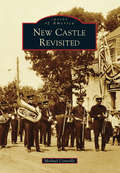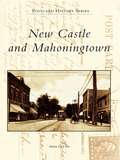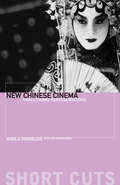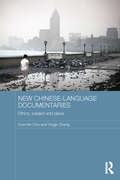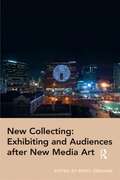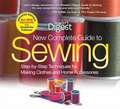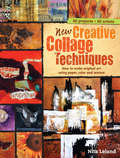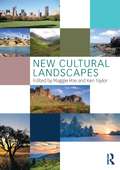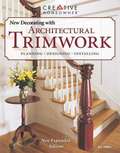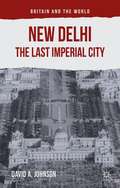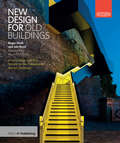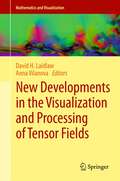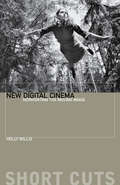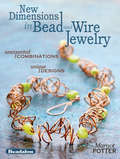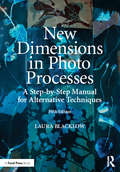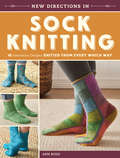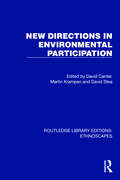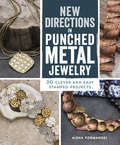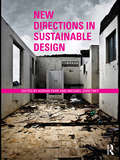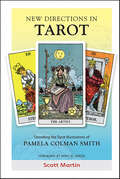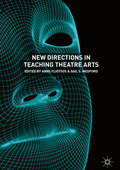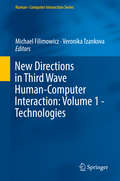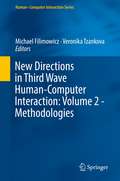- Table View
- List View
New Castle Revisited
by Michael ConnollySince its founding in 1651 on the western shore of the Delaware River, New Castle and its residents have shared in the making of American history. Known as the first capital of the first state, this charming town watched European powers clash over its control; welcomed William Penn when he first set foot on American soil; participated in the drama of the Revolutionary War, the War of 1812, and the Civil War; and reaped the benefits of new technologies like the railroad, steam engine, and aviation. Eventually, trade and commerce moved elsewhere, leaving New Castle preserved and intact. Today, the people of New Castle take great pride in their community's heritage and enjoy sharing the story of this National Historic Landmark District with others.
New Castle and Mahoningtown (Postcard History)
by Anita DevivoFounded in 1798, New Castle was a small borough located at the confluence of the Shenango River and Neshannock Creek. Mahoningtown, a small borough located just south of New Castle, was a thriving community founded in 1836. The two towns boasted flourishing industries, and in 1896, a trolley line was created to run between them. In 1898, Mahoningtown officially became the seventh ward of New Castle. By that time, New Castle was a third-class city, and railroads and steel were the area's major industries. Eventually many important products were manufactured here, including both Castleton and Shenango China, which were used in the White House. New Castle became known first as the tinplate capital of the world and, later, as the fireworks capital of the world. The stunning postcards featured in New Castle and Mahoningtown document the fusion of these two communities. Among the memorable views are the diverse scenery and amusements of Cascade Park and the parade for baseball manager Chuck Tanner, who led the Pittsburgh Pirates to their fifth World Series.
New Chinese Cinema: Challenging Representations (Short Cuts)
by Sheila CorneliusNew Chinese Cinema: Challenging Representations examines the ‘search for roots’ films that emerged from China in the aftermath of the Cultural Revolution. The authors contextualize the films of the so-called Fifth Generation directors who came to prominence in the 1980s and 1990s, such as Chen Kaige, Zhang Yimou, and Tian Zhuangzhuang. Including close analysis of such pivotal films as Farewell My Concubine, Raise the Red Lantern, and The Blue Kite, this book also examines the rise of contemporary Sixth Generation underground directors whose themes embrace the disaffection of urban youth.
New Chinese-Language Documentaries: Ethics, Subject and Place (Media, Culture and Social Change in Asia)
by Yingjin Zhang Kuei-fen ChiuDocumentary filmmaking is one of the most vibrant areas of media activity in the Chinese world, with many independent filmmakers producing documentaries that deal with a range of sensitive socio-political problems, bringing to their work a strongly ethical approach. This book identifies notable similarities and crucial differences between new Chinese-language documentaries in mainland China and Taiwan. It outlines how documentary filmmaking has developed, contrasts independent documentaries with dominant official state productions, considers how independent documentary filmmakers go about their work, including the work of exhibiting their films and connecting with audiences, and discusses the content of their documentaries, showing how the filmmakers portray a wide range of subject matter regarding places and people, and how they deal with particular issues including the underprivileged, migrants and women in an ethical way. Throughout the book demonstrates how successful Chinese-language independent documentary filmmaking is, with many appearances at international film festivals and a growing number of award-winning titles.
New City: How The Crisis Of Canadas Cities Is Reshaping Our Nation
by John LorincShaped by immigration, and demographics, our hub cities demonstrate what’s best about Canada: our commitment to education, tolerance, culture, and innovation. Since the early 1990s, however, troubling trends have threatened to undermine our much-envied quality of life. In The New City, award-winning urban affairs writer John Lorinc offers a compelling vision of how to make Canada’s metropolitan centres sustainable, livable, and competitive. Incisive and broad-ranging, this is a timely reminder that all Canadians must confront urban issues if the country is to succeed in the tumultuous economy of the 21st century.
New Collecting: Exhibiting And Audiences After New Media Art
by Beryl GrahamThe collections of museums, galleries and online art organisations are increasingly broadening to include more new media art. Because new media is used as a means of documenting, archiving and distributing art, and because new media art might be interactive with its audiences, this highlights the new kinds of relationships that might occur between audiences as viewers, participants, selectors, taggers or taxonomisers. New media art presents many challenges to the curator and collector, but there is very little published analytical material available to help meet those challenges. This book fills that gap. Drawing from the editor's extensive research and the authors' expertise in the field, the book provides clear navigation through a disparate arena. The authors offer examples from a wide geographical reach, including the UK, North America and Asia and integrate the consideration of audience response into all aspects of their work. The book will be essential reading for those studying or practicing in new media, curating or museums and galleries.
New Complete Guide to Sewing: Step-by-step Techniques for Making Clothes and Home Accessories
by The Editors at the Reader's DigestA veritable encyclopaedia of sewing, this valuable guide includes detailed directions, practical advice, work-saving tips, essential techniques, and hundreds of unique creative touches to bring out the best in needlework.
New Creative Collage Techniques: How to Make Original Art Using Paper, Color and Texture
by Nita LelandGet ready to make great art! New Creative Collage Techniques is filled with the guidance you need to make striking collages with a range of materials and mediums. It's fun and easy to jump right in, whether you're an experienced artist looking for something new or a new artist looking to make something unique. From basic methods to the latest innovations, this guide illustrates more than 60 exciting collage projects complete with detailed instruction, quick tips, charts and glossaries. In addition, seven start-to-finish demonstrations show you how to use these techniques to create your own stunning work. You'll create: Fantastic found-paper collages formed from items right within your reach Compelling collage designs using decorative and ready-made papers Mixed-media collages combining acrylics, watercolor, rice paper and more Compositions featuring textured backgrounds made from paper, paint, natural materials and other collage materials Original paper (hand made by you) artfully arranged to form collages that are uniquely yours Collage that stands the test of time through the use of archival materials and techniques You'll also be inspired to push the potential of this limitless art form by studying the diverse work of 60 featured artists. As author Nita Leland says, "Experiment. Be Creative. Have fun. You're a collage artist!" With this guide, you've got what you need to get started today.
New Critical Essays on James Agee and Walker Evans
by Caroline BlinderCoinciding with the increasing intersections between visual and literary studies, this timely reappraisal of Let Us Now Praise Famous Men sheds light on the book's unclassifiable status as part imaginative fiction, documentary effort, ethnographic study, and modernist prose.
New Cultural Landscapes: Challenges And New Directions
by Maggie Roe Ken TaylorWhile historical and protected landscapes have been well studied for years, the cultural significance of ordinary landscapes is now increasingly recognised. This groundbreaking book discusses how contemporary cultural landscapes can be, and are, created and recognised. The book challenges common concepts of cultural landscapes as protected or ‘special’ landscapes that include significant buildings or features. Using case studies from around the world it questions the usual measures of judgement related to cultural landscapes and instead focuses on landscapes that are created, planned or simply evolve as a result of changing human cultures, management policy and practice. Each contribution analyses the geographical and human background of the landscape, and policies and management strategies that impact upon it, and defines the meanings of 'cultural landscape' in its particular context. Taken together they establish a new paradigm in the study of landscapes in all forms.
New Decorating with Architectural Trimwork
by Jay SilberNew Decorating with Architectural Trimwork focuses on the aesthetic, uses architectural trim work. Plenty of books tell the reader how to install trimround windows and doors, but few also explain how architectural trim can enhance a room's aesthetic appeal. Silber shows readers even more idea so now to choose and use a wide variety of moldings, trim, and design concept to transform the all-too-common sterile, open floor plan into a warm, inviting, richly textured home, providing ideas for how to decorate homes with trim and wall panels so that walls, passageways, and stairways can radiate the warmth, character, and beauty of the well-trimmed homes.
New Delhi: The Last Imperial City
by David A. JohnsonJohnson provides an historically rich examination of the intersection of early twentieth-century imperial culture, imperial politics, and imperial economics as reflected in the colonial built environment at New Delhi, a remarkably ambitious imperial capital built by the British between 1911 and 1931.
New Design for Old Buildings
by Roger Hunt Iain BoydThis book is a celebration of good new design for old buildings and the SPAB philosophy that good new architecture can sit happily alongside old and is preferable to pastiche. Endorsing the value of architects who are engaged to work in the historic environment, this book explores design, materials and technical considerations in creating the best low energy, ecological and sustainable retrofits. It has never been more important to understand how old buildings can be adapted to make them useful and sustainable in the future. Showcasing the best examples of imaginative design and best practice, this book illustrates how old buildings can be made sustainable through the best new design and puts these design exemplars into a historical and philosophical context. With illustrative case studies and interviews throughout, including formal buildings, churches, domestic buildings, commercial, industrial and agricultural from all periods in the UK, New Design for Old Buildings provides essential guidance on good, imaginative new design for old buildings.
New Developments in the Visualization and Processing of Tensor Fields
by Anna Vilanova David H. LaidlawBringing together key researchers in disciplines ranging from visualization and image processing to applications in structural mechanics, fluid dynamics, elastography, and numerical mathematics, the workshop that generated this edited volume was the third in the successful Dagstuhl series. Its aim, reflected in the quality and relevance of the papers presented, was to foster collaboration and fresh lines of inquiry in the analysis and visualization of tensor fields, which offer a concise model for numerous physical phenomena. Despite their utility, there remains a dearth of methods for studying all but the simplest ones, a shortage the workshops aim to address. Documenting the latest progress and open research questions in tensor field analysis, the chapters reflect the excitement and inspiration generated by this latest Dagstuhl workshop, held in July 2009. The topics they address range from applications of the analysis of tensor fields to purer research into their mathematical and analytical properties. They show how cooperation and the sharing of ideas and data between those engaged in pure and applied research can open new vistas in the study of tensor fields.
New Digital Cinema: Reinventing the Moving Image (Short Cuts)
by Holly WillisThis introduction to contemporary digital cinema tracks its intersection with video art, music video, animation, print design and live club events to create an avant-garde for the new millennium. It begins by investigating digital cinema and its contribution to innovations in the feature-film format, examining animation and live-action hybrids, the gritty aesthetic of the Dogme 95 filmmakers, the explosions of frames within frames and the evolution of the ‘ambient narrative’ film. This study then looks at the creation of new genres and moving-image experiences as what we know as ‘cinema’ enters new venues and formats.
New Dimensions in Bead and Wire Jewelry: Unexpected Combinations, Unique Designs
by Margot PotterShaping wire + beading wire = a whole new dimension New Dimensions in Bead and Wire Jewelry brings shaping and beading wire together to create stunning sculptural designs. From necklaces and bracelets, to rings, earrings and tiaras, jewelry maven Margot Potter shows you how to coil, wrap, weave and sculpt 30 wire-based projects. In addition, inspirational variations on the projects provide even more reason to get wrapped up in wire. Features: Combine shaping wire with beading wire in innovative ways to create jewelry with movement, depth and dimension. Employ a variety of classic wire-working methods, including wire wrapping, twisting, coiling, chain maille and more. Love beads? You won't be disappointed. Adorn your creations with crystal, metal, Lucite and vintage beads to add your own brand of signature sparkle. Start adding depth, dimension and intrigue to your jewelry designs today with New Dimensions in Bead and Wire Jewelry.
New Dimensions in Photo Processes: A Step-by-Step Manual for Alternative Techniques (Alternative Process Photography)
by Laura BlacklowNew Dimensions in Photo Processes invites artists in all visual media to discover contemporary approaches to historical techniques. Painters, printmakers, and photographers alike will find value in this practical book, as these processes require little to no knowledge of photography, digital means, or chemistry. Easy to use in a studio or lab, this edition highlights innovative work by internationally respected artists, such as Robert Rauschenberg, Chuck Close, Mike and Doug Starn, and Emmet Gowin. In addition to including new sun-printing techniques, such as salted paper and lumen printing, this book has been updated throughout, from pinhole camera and digital methods of making color separations and contact negatives to making water color pigments photo-sensitive and more. With step-by-step instructions and clear safety precautions, New Dimensions in Photo Processes will teach you how to: Reproduce original photographic art, collages, and drawings on paper, fabric, metal, and other unusual surfaces. Safely mix chemicals and apply antique light-sensitive emulsions by hand. Create imagery in and out of the traditional darkroom and digital studio. Relocate photo imagery and make prints from real objects, photocopies, and pictures from magazines and newspapers, as well as from your digitial files and black and white negatives. Alter black and white photographs, smart phone images, and digital prints.
New Directions In Sock Knitting: 18 Innovative Designs Knitted From Every Which Way
by Ann BuddTake a step in a new direction!Go beyond top-down or toe-up construction in New Directions in Sock Knitting. In the eighteen designs curated by knitting super star Ann Budd, you'll be treated to projects that range from traditional sock patterns to more challenging and innovative sock constructions. The socks in this collection use a variety of knitting techniques including double knitting, intarsia in the round, short-row shaping, mirrored color and texture patterns, and multi-directional knitting in both traditional and innovative ways. These techniques will have you casting on and knitting your socks from unexpected places--starting at the heel or sole or even from side to side! The instructions are all written in step-by-step detail that will ensure success, no matter which design you choose to knit.Original, innovative, and unique, it's New Directions in Sock Knitting!
New Directions in Environmental Participation (Routledge Library Editions: Ethnoscapes)
by David Canter David Stea Martin KrampenOriginally published in 1988, reissued now with a new series introduction, New Directions in Environmental Participation was the third in a trilogy of books to open the series Ethnoscapes: Current Challenges in the Environmental Social Sciences. These three titles brought together specially commissioned contributions that cover much of the range of topics that the series as a whole would cover. Although the following volumes would not have the same format, the opening trilogy gave an overview of what was to come, while also providing a broad base for the future authors to build upon.For this volume the editors chose to deal directly with current developments in environmental participation. This brings together contributions that range from studies of hands-on user participation to explorations on a much broader scale of the role we all play in shaping our environment. The role of communication, education and research in the participation process is a motif that is apparent throughout the contributions.
New Directions in Punched Metal Jewelry: 20 Clever and Easy Stamped Projects
by Aisha FormanskiDiscover a simple technique that creates striking and original results. Using basic metal punch tools--dots and lines--author Aisha Formanski brings a fresh approach to jewelry-making inspired by Mexican stamped tin mirrors. Styles range from direct references to the Mexican folk art that first inspired her to geometric patterns that resemble tin ceilings or printed fabric to designs that look like Japanese sashiko or other embroidery. In addition to Aisha's stamping and design techniques, enjoy tutorials on basic metalworking skills: Riveting Creating holes Shaping Antiquing Basic polishing And filing Aisha focuses on inexpensive metals such as copper, brass, and nickel and shows how to create basic punch designs with just one stamp. She then demonstrates how the same design can be elaborated using two, three, or more different punches. The design possibilities are endless!
New Directions in Sustainable Design
by Adrian Parr Michael ZaretskyRecently there has been a plethora of work published on the topic of sustainability, much of which is purely theoretical or technical in its approach. More often than not these books fail to introduce readers to the larger challenge of what thinking sustainably might entail. Combining a series of well know authors in contemporary philosophy with established practitioners of sustainable design, this book develops a coherent theoretical framework for how theories of sustainability might engage with the growing practice of design. This book: brings together new and emerging perspectives on sustainability provides cohesive and jargon-free reading articulates the specificity of both theory and practice, to develop a symbiotic relationship which allows the reader to understand what thinking sustainably entails This volume describes a variety of new ways to approach sustainable design and it equips the next generation of designers with necessary conceptual tools for thinking sustainably.
New Directions in Tarot: Decoding the Tarot Illustrations of Pamela Colman Smith
by Scott MartinA look at how Pamela Colman Smith's theatrical knowledge and experience came into play when she drew the iconic cards of the Rider-Waite-Smith deck. The &“secrets&” in this book have been known all along, and they work in all who read Tarot on a subconscious level. This insightful book delves deeply into the images Pamela Colman Smith created for the Rider-Waite-Smith Tarot, and reminds us of what we may have known intuitively but had not been aware of on a conscious level. • A brand-new approach that focuses on how, in her images, Smith utilized a sense of direction, body movement, posture, gait, facial expression, and more • Compares the Tarot Minors to technical elements of theater, including plot, conflict, elements of a play, thought/theme, dialogue, music, and actors&’ positions on stage • Provides powerful tools for interpreting the cards and discovering new meanings that the reader can make their own • Includes thought-provoking exercises that guide the reader in the mastery of these new insights The result is a fresh take on Tarot that brings new meanings to light and enables the reader to evaluate what the Tarot provides like never before.
New Directions in Teaching Theatre Arts
by Anne Fliotsos Gail S. MedfordThis book reflects the changes in technology and educational trends (cross-disciplinary learning, entrepreneurship, first-year learning programs, critical writing requirements, course assessment, among others) that have pushed theatre educators to innovate, question, and experiment with new teaching strategies. The text focuses upon a firm practice-based approach that also reflects research in the field, offering innovative and proven methods that theatre educators may use to actively engage students and encourage student success. The sixteen essays in this volume are divided into five sections: Teaching with Digital Technology, Teaching in Response to Educational Trends, Teaching New Directions in Performance, Teaching Beyond the Traditional, and Teaching Collaboratively or Across Disciplines. Study of this book will provoke readers to question both teaching methods and curricula as they consider the ever-shifting arts landscape and the potential careers for theatre graduates.
New Directions in Third Wave Human-Computer Interaction: Volume 1 - Technologies (Human–Computer Interaction Series)
by Michael Filimowicz Veronika TzankovaAs the first extensive exploration of contemporary third wave HCI, this handbook covers key developments at the leading edge of human-computer interactions. Now in its second decade as a major current of HCI research, the third wave integrates insights from the humanities and social sciences to emphasize human dimensions beyond workplace efficiency or cognitive capacities. The earliest HCI work was strongly based on the concept of human-machine coupling, which expanded to workplace collaboration as computers came into mainstream professional use. Today HCI can connect to almost any human experience because there are new applications for every aspect of daily life. Volume 1 - Technologies covers technical application areas related to artificial intelligence, metacreation, machine learning, perceptual computing, 3D printing, critical making, physical computing, the internet of things, accessibility, sonification, natural language processing, multimodal display, and virtual reality.
New Directions in Third Wave Human-Computer Interaction: Volume 2 - Methodologies (Human–Computer Interaction Series)
by Michael Filimowicz Veronika TzankovaThis is the first extensive compilation documenting contemporary third wave HCI, covering key methodological developments at the leading edge of human-computer interactions. Now in its second decade as a major current of HCI research, the third wave integrates insights from the humanities and social sciences to emphasize human dimensions beyond workplace efficiency or cognitive capacities. Where the earliest HCI work has been strongly based on the concept of human-machine coupling, which expanded to workplace collaboration as computers came into mainstream professional use, today HCI can connect to almost any human experience because there are new applications for every aspect of daily life.Volume 2 - Methodologies covers methodological approaches grounded in autoethnography, empathy-based design, crowdsourcing, psychometrics, user engagement, speculative design, somatics, embodied cognition, peripheral practices and transdisciplinarity.
